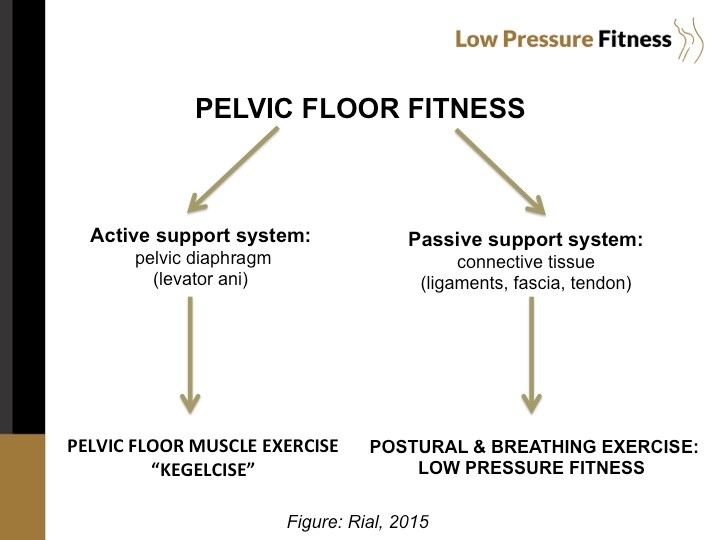In recent years, Low Pressure Fitness (LPF) has brought a revolution to the field of physical therapy as an smart alternative for pelvic floor training.
Traditionally, we have used pelvic floor muscle contractions known as Kegel exercises (Kegel, 1948) to improve the strength of the pelvic floor muscles focusing the attention on the active support system (musculature). Systematic reviews of randomised controlled trials in the general female population conclude that there is supporting evidence for the effectiveness of kegel exercises as a conservative treatment for pelvic floor dysfunctions such as stress urinary incontinence (Duomolin & Hay-Smith, 2010). Nevertheless, we also have to recognize the importance of the passive support system of the pelvic floor (connective tissue) because it is necessary to achieve an optimal balance of miofascial tissue and elascicity of the pelvic structures. These factors will be decisive to keep in the pelvic floor functioning optimally.

Low Pressure Fitness training could be a useful tool for improving both active and passive support systems. This program can easily be incorporated into a variety of approaches previously designed with the client’s goals in mind. Let’s learn a little bit more about how Low Pressure Fitness works.
The core or cylinder formed by the diaphragm (at the top), the pelvic floor (bottom) abdominal muscles (front) and lumbar (back) all work synergistically to create stability to the spine and for breathing mechanism. An imbalance or excessive tone in any of the points will have observable repercussions on the other parts of the cylinder. In this sense, the pelvic floor works in coordination and synergy with the breathing. Re-training the breathing patterns will improve our abdominal muscle stability, and at the same time will enhance the pelvic floor function. Low Pressure Fitness, is a postural and breathing program that retrains respiratory function through specific breathing exercises meanwhile rebalances posture muscles.
Some of this breathing exercises are done in association with the abdominal vacuum maneuver or rib cage lift. Consequently, the diaphragm rises and sucks up the pelvic viscera and fascial connections. This maneuver causes a decrease of intraabdominal pressure, and a stretch of vaginal connective tissue. This myofascial stretching also leads to an increase of pelvic peripheral vascularization. All, will bring better mobility to the pelvic area as a global body readjustment.
It has been found that 30% of women with some kind of pelvic dysfunction are incapable to contract their pelvic floor muscles. A recent study by Brazilian researchers (Latorre et al., 2013), found that Low Pressure Fitness techniques helped in the local proprioception of the pelvic floor. One of the main objectives for pelvic floor rehabilitation is to raise awareness of the pelvic floor and at the same time learn how to discriminate this from relaxation of the isolated muscular contractions, An example of how Low Pressure Fitness can help in pelvic floor treatment is shown in the following video
We can see the big difference between performing only voluntary contractions and a voluntary contraction combined with the Low Pressure Fitness techniques while using a biofeedback device. The maximum voluntary contraction achieved is higher with Low Pressure Fitness than with kegel exercises alone. The combination of both methods is an excellent way to improve propioception and strength of the pelvic floor as connective tissue is streched.
In short, maintaining a good balance between the fascial connective tissue and muscular components will help prevent/rehabilitate pelvic floor disorders.
Author:
Tamara Rial, for DOOLAFIT.
